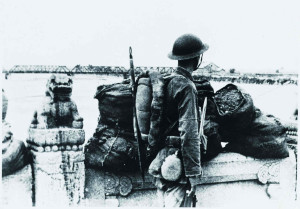Deadly Clash at Marco Polo Bridge
- By Peter Harmsen
- 7 July, 2013
- 21 Comments
 Seventy-six years ago, on July 7, 1937, Chinese and Japanese soldiers clashed at Marco Polo Bridge outside Beijing. It was the start of an eight-year war in which millions would die, mostly Chinese and mostly civilians. Below is an account of this fateful event, excerpted from Shanghai 1937: Stalingrad on the Yangtze, published by Casemate.
Seventy-six years ago, on July 7, 1937, Chinese and Japanese soldiers clashed at Marco Polo Bridge outside Beijing. It was the start of an eight-year war in which millions would die, mostly Chinese and mostly civilians. Below is an account of this fateful event, excerpted from Shanghai 1937: Stalingrad on the Yangtze, published by Casemate.
No one took any particular notice when on the evening of July 7 a Japanese company garrisoned at the town of Fengtai near Beijing set out for a night of exercises near the Marco Polo Bridge, named after the Venetian merchant who had mentioned it 600 years earlier in his memoirs. As the Japanese soldiers moved around warily in pitch-black darkness, a number of shots rang through the warm air. Apparently, they were fired by a group of Chinese soldiers camped nearby. Apprehension among the Japanese grew when the officers carried out a count and found one soldier missing.
The Japanese assumed the soldier was being held captive in the Chinese camp and went searching for him. As tense soldiers fanned out into the night, fingers on triggers, incidents were bound to happen. Scattered fighting erupted around the bridge, and the Japanese reinforcements that arrived in the following hours began shelling the nearby walled city of Wanping. In the meantime, the missing soldier had turned up, apparently having made an unauthorized visit to a brothel. By then it was too late.
Chinese and Japanese officers started negotiations to contain the crisis. After four days, they eventually managed to hammer out a truce. It was a wasted effort. The ceasefire was undermined from the start by mutual loathing and suspicion, and both sides took measures that could only escalate the conflict. On the same day that the truce was signed in China, the Japanese cabinet decided to reinforce the troops in the area around Beijing with units from Manchukuo, Korea and the home islands. The intention, abetted by Emperor Hirohito, was, in language that had already become well known, “to teach China a lesson” by subduing Chinese forces around Beijing and the nearby port city of Tianjin. The day after, Chiang Kai-shek sent a cable to the 19th Army, one of the main units stationed in the north, stating that “I am now determined to declare war on Japan.” The battle had started. There were dead and injured on both sides. A dangerous line had been crossed.

 Copyright © 2025
Copyright © 2025
Leave a Reply